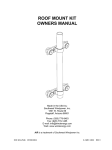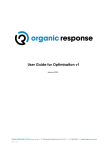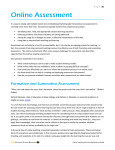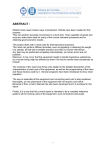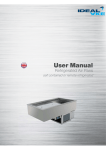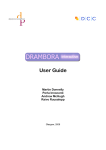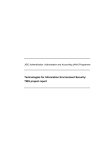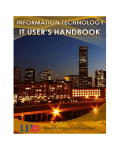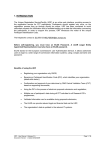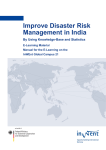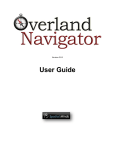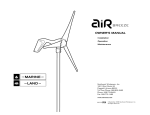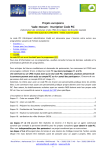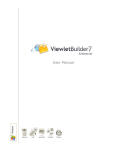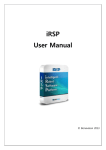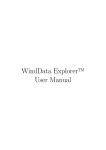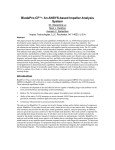Download D3.2 Trial implementation and test of two e
Transcript
Downloaded from orbit.dtu.dk on: Dec 17, 2015 Trial implementation and test of two e-learning tools Virtual Campus Hub. D3.2 Fransson, Torsten; Badger, Merete; Monaco, Lucio Publication date: 2012 Document Version Publisher final version (usually the publisher pdf) Link to publication Citation (APA): Fransson, T., Badger, M., & Monaco, L. (2012). Trial implementation and test of two e-learning tools: Virtual Campus Hub. D3.2 . Kungl. Tekniska högskolan I Stockholm. General rights Copyright and moral rights for the publications made accessible in the public portal are retained by the authors and/or other copyright owners and it is a condition of accessing publications that users recognise and abide by the legal requirements associated with these rights. • Users may download and print one copy of any publication from the public portal for the purpose of private study or research. • You may not further distribute the material or use it for any profit-making activity or commercial gain • You may freely distribute the URL identifying the publication in the public portal ? If you believe that this document breaches copyright please contact us providing details, and we will remove access to the work immediately and investigate your claim. KTH, The Royal Institute of Technology D3.2 Trial implementation and test of two e-Learning tools KTH, The Royal Institute of Technology December 2012 Torsten Fransson, Professor, KTH – Department of Energy Technology Merete Badger, Senior Scientist, DTU – Department of Wind Energy Lucio Monaco, PhD student, KTH – Department of Energy Technology D3.2 Trial implementation and test of two e-Learning tools KTH, The Royal Institute of Technology Contents 1 Introduction ............................................................................................................................... 1 2 Remote labs ............................................................................................................................... 2 3 4 2.1 Trial Implementation ......................................................................................................... 2 2.2 Methodology...................................................................................................................... 2 2.3 Evaluation .......................................................................................................................... 3 2.3.1 Evaluation by participants.......................................................................................... 3 2.3.2 Evaluation by the course trainers .............................................................................. 7 2.3.3 Future work ................................................................................................................ 8 Continuous Examination Tools ................................................................................................ 10 3.1 Trial implementation ....................................................................................................... 10 3.2 Evaluation ........................................................................................................................ 10 3.2.1 Evaluation by course trainers................................................................................... 10 3.2.2 Evaluation by students ............................................................................................. 12 DTU’s WASP Course ................................................................................................................. 13 4.1 Course development ........................................................................................................ 13 4.2 Trial implementation ....................................................................................................... 13 4.3 Testing .............................................................................................................................. 15 4.3.1 Evaluation by course participants ............................................................................ 15 4.3.2 Pedagogical learning points ..................................................................................... 17 4.3.3 Technical learning points ......................................................................................... 17 4.4 Further steps .................................................................................................................... 18 D3.2 Trial implementation and test of two e-Learning tools KTH, The Royal Institute of Technology 1 Introduction This document describes the trial implementation and test of some of the VC Hub e-learning tools in on-going educational programs and courses at Master and Ph.D. levels. The following aspects are covered: • • The remote cascade lab, the remote pressure measurement lab and the continuous examination tools developed in WP2 have been tested internally (i.e. with students enrolled in courses at KTH) and evaluated; partial access to the material is given to the public. The online course (WASP) in wind energy has been run with participants from DTU and evaluation is complete; The deliverable is send with three weeks delay given the opportunity to include the evaluation of the remote cascade lab in additional courses of relevance (besides the one included in the selection of test cases in WP3) and of the internal evaluation of the remote pressure measurement lab, not originally part of the present deliverable. D3.2 Trial implementation and test of two e-Learning tools 1 KTH, The Royal Institute of Technology 2 Remote labs 2.1 Trial Implementation The remote cascade lab (RCL) has been first tested with students during the spring 2012, as part of a laboratory exercise in the Master’s level course MJ2430 Thermal Turbomachinery at KTH. At this time the remote capabilities where still very limited, and a strong involvement of the laboratory assistant in setting up and starting the system was necessary. A fully autonomous operation of the lab has been achieved during the autumn 2012, with the introduction of the remote cascade lab in the MJ2429 Turbomachinery and MJ2241 Jet Propulsion Engines courses at KTH. Observations and evaluation reported here are based on the experience gained during these last laboratory activities that have involved overall more than 100 course participants. The remote pressure measurement lab (RPML) has been first tested with students during the fall term 2012, as part of a laboratory exercise in the Master’s level course MJ2440 Measuring Techniques at KTH. Observations and evaluation reported here are based on the experience gained during the aforementioned laboratory activities that have involved 85 course participants. Methodology 2.2 The remote cascade lab and the remote pressure measurement lab are integrated in on-going courses at KTH. The laboratory exercise is scheduled such that it takes place right after the participants have come across with the theory of relevance during classes. To ensure a large pool of remote users, both on-campus and distant students execute the various activities with the same methodology. No direct interaction with the lab assistant is allowed, and on-campus students have access to visit the on-site facility just after completion of the exercise. The laboratory exercise is presented to the participants as a sequence of activities, some to be performed in group and some individually: • Self-study based on a recorded lecture and on the lab notes made available as Podcast. In the recorded lecture the course leader goes through the theory of losses, followed by the lab assistant giving an introduction to the experimental activity and live demonstration of the remote lab. For the RPML self-study is based on the lab notes only. • Online individual self-assessment (RCL only). The test – performed in the local LMS consists of multiple choice questions concerning the theory of losses and the measurements to be performed. Only students who successfully complete the selfassessment are granted access to the remote lab. No self-assessment is included in the RPML exercise; • Time reservation for the control of the lab. The time slot is two hours long and the booking is done via a doodle event in the case of the RCL while the time slot is one hour long and is done in the local LMS in the case of the RPML. Each participant can choose D3.2 Trial implementation and test of two e-Learning tools 2 KTH, The Royal Institute of Technology one time only, and up to six students in the case of the RCL or up to five students in the case of the RPML can register for the same time slot; • Planning of the activity. Students who have signed up for the same time need to agree on how they are going to perform the lab session (e.g. how to communicate, which measurements to perform). The group has also to make sure that at least one computer is available with the required software and test it, as specified in the lab notes; • Perform the measurements. At the reserved time, students have access to the graphical user interface for the control of the lab and to the monitoring cameras. In the case of the RCL the lab notes contain a user manual and a brief tutorial with the step by step procedure to follow to obtain a first set of measurements. Following measurements are to be decided by the group, as to achieve the intended learning outcomes. In the case of the RPML the lab notes contain a user manual, a brief tutorial as well as the complete list of measurements to be performed;; • Analyse the data and write a report. The data obtained are to be analysed and findings to be resumed in a group report to be submitted in the local LMS for evaluation. All the various activities part of the laboratory exercise are monitored by the course trainers. Participants are also invited to compile an online evaluation form in the local LMS. The survey which is not compulsory and is treated anonymously – represents a feedback for the improvement of the lab exercises. The form used for the evaluation of the RPML is the same used for the RCL with the exception of the section dedicated to the learning outcomes. 2.3 2.3.1 Evaluation Evaluation by participants Follows a summary of the evaluation forms filled out by the course participants who have participated at the remote laboratory exercises. Remote cascade lab (RCL): MJ2429 Turbomachinery 25 out of 99 1 students filled out the form MJ2241 Jet Propulsion Engines 10 out of 331 students filled out the form Remote pressure measurement lab (RPML): MJ2440 Measuring Techniques 26 out of 85 2 students filled out the form 1 2 Students that have logged-in at least once to the self-assessment Students that have had access to the laboratory material (lab notes, links, etc.) at least once D3.2 Trial implementation and test of two e-Learning tools 3 KTH, The Royal Institute of Technology Remote experience 1 2 3 4 5 1. How do you rate the online performance of the experiment (in terms of technical performance, i.e. having the equipment doing what you want it to do)? 2. How well did you have control over the laboratory equipment (in terms of you knowing what to control and how to do this)? 3. How well did the laboratory handouts prepare you for doing this laboratory exercise? 4. How intuitive and easy to use was the GUI (Graphycal User Interface)? 5. How well did remote cameras (including audio) transmit the lab experience? RCL (MJ2429) RCL (MJ2241) RPML Figure 2-1: Rating of the remote laboratory experience. Scale: 1 = bad; 2= weak; 3 = OK; 4 = good; 5 = excellent. 0% 20% 40% 60% 80% 1. Did you read the laboratory instructions prior to performing the laboratory exercise? 2. Could you perform the laboratory exercise smoothly, i.e. without interruptions? 3. Could you measure and analyze the data successfully? 4. Did you understand what you were doing during the laboratory exercise? 5. Did the absence of a physical lab instructor hinder you in performing the laboratory exercise? 6. Would you like to perform a similar laboratory exercise again? 7. Do you think that performing experiments through remote labs was more challenging than real experiments? yes no can't say Figure 2-2: Closed-end questions regarding the remote laboratory experience. D3.2 Trial implementation and test of two e-Learning tools 4 100% KTH, The Royal Institute of Technology Learning objectives The following data reflect the feeling of the participants with respect to the achievement of the intended learning outcomes. 1 2 3 4 5 1. I am able to perform experimental testing of turbine blade rows based on probe traversing. 2. I can determine the aerodynamic losses of a turbine cascade based on experimental data. 3. I am able to undertand and to investigate the influence of the flow parameters (inlet angle, Mach number) on the aerodynamic losses of a turbine cascade. 4. I can reflect on the observed phenomena and relate them to what taught during lectures. RCL (MJ2429) RCL (MJ2241) Figure 2-3: RCL - Achievement of the intended learning objectives. Scale: 1 = bad; 2= weak; 3 = OK; 4 = good; 5 = excellent. 1 2 3 4 5 I understand the main principles of the static pressure measurements. I can explain what impact has the geometry of the pressure tap on the measured pressure values. I understand the main principles of the aerodynamic probe calibration. I can reflect on the observed phenomena and relate them to what taught during lectures in the course. Figure 2-4: RCPML - Achievement of the intended learning objectives. Scale: 1 = bad; 2= weak; 3 = OK; 4 = good; 5 = excellent. D3.2 Trial implementation and test of two e-Learning tools 5 KTH, The Royal Institute of Technology Interesting aspects Among the interesting aspects, participants from both the RCL and RPML underline the following: • Being able to collect real data and see the measurement being taken live; • The user interface is well-designed and easy to operate and the lab equipment feels very professional; • Challenging because you don't have a lab instructor to help you out when you're in trouble (good "real life" experience); • Possibility to perform the lab in a more comfortable place (without noise and wind, while eating, etc.); Difficulties and Problems Among difficulties and problems encountered during the laboratory exercise, participants from both the RCL and RPML underline the following: • Problems installing the software (LabView RTE) for controlling the lab. Some students consider unacceptable the installation of the software on a private computer; • RCL only: the objectives (in particular which measurements to perform) are not stated clearly in the lab notes; • The view from the camera doesn’t transmit fully the perception of a real lab, and some details are hard to identify. In the case of the RPML the video is disturbed by the shaking of the camera; • RPML only: the laboratory exercise was not properly introduced during lecture; • RPML only: a group was disturbed by external participants trying to connect to the graphical user interface at the wrong time; • When a question appeared it took more time to solve it due to the absence of a teacher. Additional comments From the additional questions asked to the participants the following aspects can be highlighted: • Most of the participants (70% MJ2229, 70% MJ2241, 62% MJ2440) think that it would be beneficial to integrate such laboratory exercises during lectures to highlight and discuss practical aspects while having it in an exam would just confuse them (52% in MJ2429, 70% in MJ2241, 46% in MJ2440); • On-campus participants would prefer to have the real lab in-place or at least to be able to see the equipment in reality; • Participants would like to have more guidance during the measurements (RCL). D3.2 Trial implementation and test of two e-Learning tools 6 KTH, The Royal Institute of Technology 2.3.2 Evaluation by the course trainers Technical From a technical point of view the remote cascade lab and the remote pressure measurement lab have shown a very high degree of reliability and easiness to be used. The following aspects for both labs can be underlined: • No intervention or technical assistance to the students has been necessary. Exception is for one single event - on December 3rd - when a blackout has interested large parts of the city, including the KTH main campus. This has made impossible for the participants (21 who had booked the RCL on that day) to perform the measurements. This is reflected in some of the answers by the course participants. • Students have managed very well in controlling the laboratory equipment, in performing the measurements and in retrieving the data, with a minimum of latency time and without threatening at any time the safety and operability of the system. This is considered to be a good achievement given the complexity of the experimental setup. • Most of the groups have succeeded in installing the required software for the control of the lab and in testing it in advance. For the on-campus students that did not manage, a computer with the required software has been made available at the time of performing the laboratory. Work is currently done for moving to a completely web-based solution that does not require any software installation to the end user and that is regardless of the operating system. • Very short time (15 min) of physical presence of the lab assistant is required for switching the setup of the facility to operate as RCL or as RPML; • While not reported by the participants, it is thought that a better integration of the various elements (such as self-assessment, lab reservation and access to the GUI in the same online platform) should be achieved. An additional consideration concerns the deployment time of the RPML. As specified in D2.1, the RCL has been built with a modular design concept, where few changes in the setup allow for the arrangement of different experiments. This principle has worked very well in the case of the RPML that had an overall development time of approximately four weeks. Pedagogical From the pedagogical point of view students have participated in all activities of the laboratory exercise – both in the case of the RCL and of the RPML - and shown interest in having remote access to such advanced instrumentation. Some common aspects can be underlined: • Description and introduction to the lab: participants have appreciated the introductory lecture given for the RCL while have suffered from the absence of such a lecture in the RPML; D3.2 Trial implementation and test of two e-Learning tools 7 KTH, The Royal Institute of Technology • Self-assessment: the self-assessment for the RCL shows good achievement of the prerequisites, with 78 out of 99 in MJ2429 and 30 out of 33 in MJ2241 respectively participants successfully completing the test. A question in the evaluation form should be included that assesses the effectiveness and utility of the self-assessment from the student’s perspective; • Lab notes: participants in the RCL have found a lack of detailed instructions for which measurements to make in order to achieve the learning objectives. On the contrary, participants in the RPML did not suffer of this problem because the set of measurements to be performed was given, as well as the objectives of the lab were better stated. • Lab groups: in the present tests groups were formed based exclusively on the students’ time preferences. This is thought to be easier to handle compared to previous experiences were groups were first formed by the trainer as a mix of people from different locations (on-campus and distant students) and then asked to decide upon one of the available time slots (in this latter case some students claimed that other members were not collaborating). As a drawback, the approach used here can potentially hinder the formation of multi-locational teams due to the fact that students that already know each other (e.g. studying on-campus) tend to form their own groups. • Lab execution: in the case of a remote laboratory exercise the performance of the students depends substantially on the level of detail of the lab notes. Due to the absence of a physical instructor that can correct or guide the users, two different approaches can be used: the set of measurements to be done is imposed and is clearly specified in the lab notes; the planning of the measurements is clearly stated as a fundamental learning objective and a fraction of the time reserved for the lab must be dedicated to that. A general recommendation is to introduce in the lab notes a set of questions after each measurement that helps the student understanding whether he/she is on track or not. • Evaluation process: the group report is used to assess the student’s achievement of the intended learning outcomes as in the case of the corresponding on-site lab. The absence of a physical guidance in the lab has the positive effect that conclusions drawn by the participants are less influenced by the comments given during the lab and it also ensures that all groups receive the same amount of information. In the case of the RCL the results achieved depend largely on an appropriate planning of the measurements and on the level of preparation before getting access to the lab. The evaluation by participants shows good confidence with respect to the achievement of the intended learning outcomes. To be noticed that the evaluation form was made accessible to the students after completion of the measurement session and before submission of the group report. This can have affected the results and it is planned for the future tests to give access to the survey only after completion of the complete laboratory exercise. 2.3.3 Future work The technical solution has met the expectations and no big modifications are planned on that side. The present effort is on the implementation of the authentication and authorization systems D3.2 Trial implementation and test of two e-Learning tools 8 KTH, The Royal Institute of Technology according to requirements specified for the VC Hub technology. A solution is also tested for allowing control of the laboratories without software installation required. On the pedagogical side effort will be spent towards the improvement of preparatory material according to the participants’ feedback, in including the self-assessment in the RPML, and in refining the survey form. Information on the RCL is currently available at the following link: http://www.energy.kth.se/proj/projects/Remote_labs/RL/RCL/RCL.html Permission to control the RCL and the RPML and the preparatory material can be required to: [email protected] D3.2 Trial implementation and test of two e-Learning tools 9 KTH, The Royal Institute of Technology 3 Continuous Examination Tools 3.1 Trial implementation At the Heat and Power Technology division at KTH multiple choice questions (MCQs) and calculation exercises for automatic correction have been developed and used as study material over the past years. Taking advantage of the functionalities of the LMS in use at KTH, Bilda (PING PONG), more sophisticated pools of questions and exercises have recently been implemented and tested for computer-based exams, self-assessments and assignments in various master’s courses. These include Turbomachinery, Applied Heat and Power Technology, Renewable Energy Technology, Sustainable Power Generation and Combustion Theory. Description of the development of the MCQs has been included in D2.1 Pedagogical improvement of e-learning tools – Interim Report. Reported here are some of the experiences of the trainers involved in the implementation of the online exercises and assessments in the aforementioned courses. Students’ perspective is mainly based on the course evaluation surveys collected in the MJ2429 Turbomachinery (2011 and 2012) and MJ2340 Thermal Turbomachinery (2012) courses. 3.2 Evaluation 3.2.1 Evaluation by course trainers Technical From the technical point of view the implementation and use of the aforementioned continuous examination tools are appreciated by trainers mainly for the time saved during the assessment process of students and the easier handling of distance-based exams, while some concerns are about ensuring that the exam and the automatic correction are disregarded from technical failures. More specifically, trainers underline the following: • The preparation time of computer-based exercises is longer, requiring both knowledge of the subject – in particular to create the sub-tasks - and programming skills. However, this is compensated by the time saved in the correction of the exercises; • Once the MCQs are programmed, they can be reused several times. This is possible given the availability of large databases and proper use of the randomization of the answers and number of correct and incorrect alternatives presented to the students. Another potential advantage is the possibility for teacher to easily exchange exam material; • With online self-assessments and exams it is easier to handle the assessment of students on remote basis, thus facilitating distance-based learning; • A detailed review of the questions before programming can minimize technical errors, but script crashes can occur, no matter how advanced the programming methods are. Server breakdown during an exam can also occur. D3.2 Trial implementation and test of two e-Learning tools 10 KTH, The Royal Institute of Technology Pedagogical From a pedagogical perspective many are the considerations in favour of the use of the continuous examination tools in the assessment of the students. Among the others: • enforce learning by doing, giving students the chance to do self-assessments several times and receiving feedback immediately; • objective assessment of the students based on an algorithm for automatic correction; • in an automatically corrected exam the answers to the questions are more precise, thus avoiding unnecessary text and facilitating to handle possible complains by the students; Several are also the drawbacks underlined by the course trainers. Among the others: • exams based on MCQs are observed to be easier compared to open-ended questions based on the fact that MCQs provide the students with ready-made answers instead of forcing the students to use their own words; • sub-tasks in the calculation exercises might guide the students to the solution; • it might be difficult to create questions in the MCQs format for some, very specific, topics; • if partial marking of MCQs is used, there is the possibility that the student chooses all possible alternatives and yet gets points. This imposes restrictions on the number of possible correct and incorrect alternatives to present, • if the same MCQs are used repeatedly (e.g. both in self-assessments during the course and in the final exam or over several years) there is the possibility that students create databases of questions. This can be avoided building even larger pools of questions and answers. A comparison of students’ grades has also been made between paper based and automatically corrected exams. Some results are shown in Figure 3-1 and Figure 3-2 for the calculation part and the theory section respectively of an exam. An important consideration is that the two forms of exam – paper-based and online-based – cannot be considered as directly comparable. Because of the factors mentioned above, the formulation of the MCQs was different from the corresponding open-ended questions, as well as the sub-tasks needed in the calculation exercise for automatic correction might have influenced the outcome for the students thus explaining the better results. At the same time, the higher grades could be attributed to the fact that students got training during the course in selfassessments including MCQs and calculation exercises thus being more prepared at the moment of the exam. D3.2 Trial implementation and test of two e-Learning tools 11 KTH, The Royal Institute of Technology Percentage of students 40% 36% 35% 35%36% 30% 18% 20% 15%14% 15% 10% 5% Fully paperbased exam (out of 181) 23% 25% 4% 1% Fully computerbased exam (out of 140) 8% 4% 5% 0% 0-4 4-8 8-12 12-16 16-20 20-24 Score out of 24 Figure 3-1: Comparison of students' results for paper based and automatically corrected calculation type exams Percentage of students 60% 55% 55% 50% 40% 30% 21% 20% 10% 0% Manually corrected (out of 29) 32% 3% 1% 0-10 17% 5% 11-20 3% 21-30 31-40 Score out of 50 7% Automatically corrected (out of 82) 41-50 Figure 3-2: Comparison of students' results on a theory section manually corrected and automatically corrected exams 3.2.2 Evaluation by students In general students are positive towards the adoption of computer-based assessment methods. Based on the course evaluation forms, very highly appreciated is the extensive use of computer resources, of the LMS, and of the online self-assessments in particular, being them useful for assimilating the notions of the course week by week and in preparing to the exam. With respect to the online exams students like the fact that results are available shortly after they have submitted it and also the way answers are handled objectively by the system. As a drawback, some of them think that online exams are unfair regarding the ability to show understanding of the course. Some are also not confident (or aware) that in the calculation type exercises the procedure followed to get to the results is also evaluated. D3.2 Trial implementation and test of two e-Learning tools 12 KTH, The Royal Institute of Technology 4 DTU’s WASP Course As part of WP3 (task 3.2), an online course in wind energy has been prepared and tested by the Department of Wind Energy at DTU. The course is based on an existing course called ‘WAsP’ (Wind Atlas Analysis and Application Programme, see also www.wasp.dk). WAsP is the industry standard tool for wind resource assessment with more than 3,600 users worldwide. The WAsP training course is mainly directed towards the wind energy industry and to Ph.D. students. The course has been run 84 times since 1991. Income generated by the WAsP software and courses is used to improve the tool through new research and development in wind power meteorology. DTU is currently investigating how the WAsP course can become a master course with ECTS credits and how it is best offered to students at the master level e.g. as part of mobility programs. 4.1 Course development The online WAsP course has been developed by scientists at DTU together with an external Elearning consultant (not funded through the project) who has helped the scientists decide on the pedagogical concept and technical solutions for the course. A series of workshops have been held to define the course structure and review the status of the course development. Between workshops the scientists have worked on the course content. Evaluation forms have been developed by DTU’s Learning Lab for collection of student and teacher feedback. 4.2 Trial implementation DTU has not got a standard learning management system (LMS) at present and it was therefore necessary to choose an LMS from a commercial provider to hold the WAsP course. The LMS itslearning was selected based on recommendations from DTU’s Learning Lab and from the external E-learning consultant. itslearning is a cloud service developed in Norway and distributed in Denmark by the company UNI-C. The LMS offers a range of functionalities which are tailored to online teaching and learning such as planning tools, discussion fora, tools for testing and surveys, for monitoring of students, and for organizing learning material. The WAsP course can be viewed with the following guest account: WAsP course URL: https://windenergy.itslearning.com/index.aspx User name: guest Password: Online2306 At present, course participants are given a user name and password to itslearning once they enroll in the WAsP course. Users and groups are managed locally inside the LMS. Work is in progress to connect itslearning to WAYF (the Danish federation) and eduGAIN (the European infrastructure), as part of WP5 of project Virtual Campus Hub. This means users from the partner universities will be able to login to itslearning with the user name and password from their local institution. Group management will be handled centrally. The online WAsP course was fully implemented in itslearning and ready to run by the end of September 2012 and it has contributed to D3.1 Prototype implementation of e-learning tools and incubator processes. D3.2 Trial implementation and test of two e-Learning tools 13 KTH, The Royal Institute of Technology Figure 4-1. E-lesson example from the second module of the WAsP course where socializing exercises are combined with scientific content. D3.2 Trial implementation and test of two e-Learning tools 14 KTH, The Royal Institute of Technology 4.3 Testing The first test of the WAsP course started on October 22 with 12 participants from DTU (scientists, students at Ph.D. and master level, visiting scientists) who followed the course in a compressed form with two modules per week during five weeks. A set of requirements were set up which the students had to fulfill in order to pass the course and receive a course diploma (Table 1). Table 1. Requirements for participants to pass the WAsP course and receive a diploma. Requirements In order to pass the course and get your diploma, you must fulfil the following requirements: • • • • • • You have completed at least eight of the 10 course modules by their end time You have contributed to group discussions in a meaningful way, and have made comments relevant to the topic(s) You have replied to questions or comments made by teachers and fellow course participants You have posted a minimum of two separate times per module You have made appropriate citations to sources you have used You have respected a word limit of 150 words per post The internal test run was completed on November 26, 2012. At this point, nine of the 12 participants had lived up to the requirements for getting a course diploma. Three participants were a bit behind schedule – perhaps due to the compression of the course – and were given an extra week to complete it. 4.3.1 Evaluation by course participants Evaluation forms were filled out by the participants after each course module (Table 2) and also by the end of the course. The feedback from course participants is used to improve the course for future runs and also to estimate the time it takes to complete each course module more accurately. This information is needed for the assessment of ECTS credits to the course and also to achieve a better match between participant expectations and reality when it comes to the workload associated with the course. The participant evaluation forms are embedded in the online course and filled out electronically. The LMS has functionalities for basic analysis and organization of the participant feedback. In the following, the most important pedagogical and technical learning points from the course are described, based on the participant feedback. The complete evaluation by participants is here included in appendix. D3.2 Trial implementation and test of two e-Learning tools 15 KTH, The Royal Institute of Technology Table 2. Example of participant evaluation after a course module (Module 2) How many minutes did you approximately spend on this module? Please mention two things about this module Please mention two things about this module you really liked. we could improve. 1 150 min exercise - using the software presentation "Measuring the wind" 2 3hrs - The GIGO principle :) - Alfredo Pena Respondent 3 4 First hand on WAsP :-) Pretty easy to use and move around in the GUI application. There are a few differences between the oral presentation and the notes in the slides. The available WAsP Climate Analyst 2 Help Facility The questions (to start the Discussion forum) are not always very clear in my point of view Wind meteorology is explained very well The sub.module 2.4 is very difficult probably because is very fast. I was unable to understand how to operate with data without reading Help file for the program. For example, only there was explanation why I can see only first 25 lines. given information on measuring technique replies from the moderator Last presentation could be perhaps a recorded video. It could be easier to follow the steps and stating "click here, double click there" would then be unnecessary 1 to 2h 180 minutes 200 5 It definitely takes more then you predicted only reading the forum 1. the lectures are nicely organized for 2.1 to 2.3 6 3 - 4 hours 2. the moderator answering the queries is very useful 1)chance to work with WaSP Climate Analyst 7 could not load slides 12-16 in "measuring the wind" presentation show a video how Climate Analyst is used instead of screenshots within the presentation. - Show more steps in the presentations for the exercise (got confused where to click at some point) - Søren's chair noise in the presentation :) 180 2)Discussion forum on exercise 1.I am learning WAsP or wind metrology fundamentals for the first time, it is necessary to support with some detailed notes for our learning or reference notes to read more details, which can help in building fundamental knowledge regarding "wind climatology", "similarity principles", "analysing wind data", etc are needed. 2. A video demonstrating exercise 2.4 with step 1 (uploading data files) to final results. Slides shown in 2.4 presentation file is not sufficient. 1)I'd like to have more details on how to approach the exercises; 2)opportunity to have some similar example to follow for exercises. 1. Double and triple posts on some slide notes at 2.1, grammar check is also needed. 8 9 about 4 hours 150 1. Forum discussions 2. Alfredo's responses to questions - Start working with WAsP - Playing with real data sets 2. To extend the time limit for editing a thread for a couple of hours (now it is 15 minutes), so we can correct grammar mistakes etc. - Testing Weibull Fitting (maybe mean Wind Speed and Power density of the histogram and weibull distribution could be similar but the whole weibull distribution doesn't match the histogram... I do not believe that measuring the differences between those values could give me a reasonable answer - WAsP should have a tool to check variabilities in different scales. It is no so hard to improve a tool in that way. - the 2 first presentations had some slides that were too repetitive. 10 11 12 3 and a half hours - points 2.1, 2.2 and 2.3, very well presented - the discussion forums, very active - I didn't find the presentation of 2.4. very helpful. Had to watch it serveral times before starting the exercise. It might perhaps help if it were an animation, following all the steps, instead of a power point. More or less none, as I came late to this module the exercise solution was already there. There was a certain portion of repetition in ppt presentations. Intended or ..? 180 Good exercise. 180min the step-by-step file by Alfredo finally created the right link between the theory and the button-clicking procedure, leaving me free to concentrate on the ideas driving the exercice sliglty clearer question number 7 instead of fooling around looking for commands... this I think is the right way. D3.2 Trial implementation and test of two e-Learning tools 16 KTH, The Royal Institute of Technology 4.3.2 Pedagogical learning points The pedagogical aspect of the course worked very well. All participants were active in the discussion fora and lived up to the criteria of posting a minimum two separate times per module. Posts from the fastest participants helped the others to complete the WAsP exercises. Several times the participants helped each other solve a specific problem before the E-moderator got involved. Other important learning points were: • Power Point presentations with speak were well received and students liked that they could return to the learning material at any stage. Some topics, which are beyond the scope of the course, were mentioned briefly but not explained in detail. Participants got confused about this and asked many questions. In future courses the relevance of different topics must be emphasized. • The display of solutions for the WAsP exercises was not sufficient, as it was difficult for participants and E-moderators to figure out why some results deviated from the solution. A step-by-step demonstration of how to solve each exercise must be given in future courses (preferably as screen casts). • All results and discussions were communicated in discussion threads. The format could be more varied in future courses e.g. by introducing quick self-tests or group work. 4.3.3 Technical learning points Overall, both participants and E-moderators were satisfied with the LMS and its functionalities. Two minor issues were criticized about the LMS: • Forward and back buttons in the web browser are disabled • It is not possible to setup alerts when new discussion posts have been made. As a consequence, it is necessary for participants and E-moderators to login frequently to check for new posts. Some additional learning points on the technical side include: • The recorded presentations were made with Adobe Presenter and output in flash format, which is incompatible with some widely used mobile devices (Apple products). Some participants would benefit from having access to the presentations anywhere e.g. during their daily commute. A solution to this technical problem should be found for future course runs. • The sound quality of recorded presentations must be improved for future course runs and studio-quality recordings at DTU Learning Lab are therefore planned. D3.2 Trial implementation and test of two e-Learning tools 17 KTH, The Royal Institute of Technology 4.4 Further steps In the second year of project Virtual Campus Hub, the WAsP online course will be further developed according to the feedback collected from the first test run. A second test run is planned for February-April 2013 where the course will run over 10 weeks with approximately 20 participants divided in two groups. The participants will be recruited from the other project partners and from the wind energy industry. The existing gap between WAsP courses and WAsP certification will be narrowed through the introduction of a self-test, which participants can take after the course, or later, to see if they have built enough knowledge and experience to take the certification exam. Finally, the process of assigning ECTS points to the course will continue in order to implement it in existing university programs and courses. References Salmon, G.: "E-moderating. The key to teaching and learning online", Routledge Falmer, 2011 (third edition 2011) D3.2 Trial implementation and test of two e-Learning tools 18 User Evaluation Page 1 of 7 User Evaluation Back to Select result Number of respondents: 10 1. Open question General User Evaluation 1. What were your expectations prior to the course? • I would like to learn what is WAsP to understand its basis principles • 1. To learn basis principles behind Wind resource assessment and the feasibility study for wind farms planning and calculations behind the AEP for a wind farms. 2. To learn WAsP basic principles 3. And also to practise WAsP software by following the excercises developed in the course • My expectations were: • • • • • • • After taking the course, have all the tools to make correct and complete wind resource analysis, including analysis of uncertainties. get a good insight into the whole WAsP Machinery, and its application To learn how to use wasp and to get some information on wind climate Being able to use WAsP in a (almost) real situation as in the exercice. Understand the background principles. My expectations were that I would just learn "another software" but I was agreably surprised by the quality of the content. I was expecting to learn how to avoid the most common mistakes when using WAsP. (I already had some experience) To get the basic ideas of WAsP software is capable of doing (including its limitations). opportunity to start working with WAsP 2. Multiple choice question Percentage 2. Did the course live up to your expectations? Yes, exactly 60% Yes, partially 40% No 0% No, not at all 0% 3. Multiple choice question Percentage 3. How did you find the level of the course? Excellent 20% Very good 30% Good 50% Not so good 0% Poor 0% 4. Multiple choice question Percentage 4. The user and authorisation management for this course was: Excellent 20% Very good 70% https://windenergy.itslearning.com/test/show_survey_result.aspx?TestID=562&Type=1 11/29/2012 User Evaluation Good Page 2 of 7 10% Not so good 0% Poor 0% 5. Open question 4. Comments to user and authorisation management: • • • • • • • • • no comments, all of them reply in time No specific comments Regarding the starting of the course, afterwards everything worked fine None Authorisation management? The moderators of the forum were friendly and always willing to answer student questions. Especially the ?open? times for different modules can be relaxed, if not removed so all modules are free accessible to user/student by default • I thought it was accessible and easy to use 6. Multiple choice question Percentage Usability 5. The user-friendliness for the online course was: Excellent 60% Very Good 20% Good 20% Not so good 0% Poor 0% 7. Open question 5. Comments to the user-friendliness: • the course itself is very good, some practical things that can help during exercises are missed • Mainly the online course is very well designed and informative enough where the user can define his own time for attending or following the course contents. • • I think I mentioned it somewhere earlier: would be nice to have one download archive containing all files that are needed throughout the course • The layout is very good. although the course dashboard with "the latest changes" can be a bit messy • May be more flexibility in the time-line decision for each user • Good and simple framework. The modules are easy to follow. • Very easy to use this e-learning layout. • Maybe a ?guided? tour (a quick YouTube like tutorial) in the WAsP world (hierarchy, structure of projects/workspaces etc.) can be included early on in the course. • I haven't had any technical problems 8. Multiple choice question Percentage 6. The structure of this course was: Excellent 40% Very good 50% Good 10% Not so good 0% Poor 0% 9. Open question https://windenergy.itslearning.com/test/show_survey_result.aspx?TestID=562&Type=1 11/29/2012 User Evaluation Page 3 of 7 6. Comments to the course structure: • some part of module 9 should be shifted to earlier stages • The course structure is excellent, only at few places some repitition is there otherwise it is nicely designed • • very nice, and easy to follow. gradually increasing • The modules followed each other nicely and the case study was very well designed • May be module 9 before module 8. • • • • Put more emphasize on these subjects: - d(RIX) analysis - P50 75 90 and how to use them in an example (exercise) Besides some reorganisation of the modules needed, the structure was clear and in a logic order. I would prefer to also learn about uncertainties and how to cross predict two met masts with an exercise. So after the case study it would be nice to have another one more advanced for WAsP familiar students. The help part can be integrated in the rest, otherwise nice ?. the structure was appropriate but I would have preferred more practical than theory 10. Multiple choice question Percentage 7. The navigation in the online course was: Excellent 40% Very good 10% Good 30% Not so good 20% Poor 0% 11. Open question 7. Comments to the course navigation: • no comments • No specific comments • • maybe a bit less menu items in the course models would be nice, since it makes navigation a bit easier • I always forgot that if I leave my forum posting to check what somebody else said, I loose all that I wrote • Sometime difficult to go back, or one would like to have two sessions in parallel. For example one for seeing the documents and one for posting on the forum. It is not possible to have both at the same time on one window... • A very "top-down" navigation, easy to follow • Easy to navigate but in the forum navigation when someone has upload a huge picture, it is difficult to see it on a 15' screen laptop. Also some times the forume was very widely expanded. • No. • I had some problems to open presentations: often opened in two windows at once 12. Multiple choice question Percentage Course Design 8. The amount of text was: Too high 10% Sufficient 80% Too little 10% 13. Open question https://windenergy.itslearning.com/test/show_survey_result.aspx?TestID=562&Type=1 11/29/2012 User Evaluation Page 4 of 7 8. Comments to text amount: • no comments • Needs to improve little bit supporting with the references and text book materials or literature data • • the notes for the presentations could be a bit condensed I think. when going back to earlier presentations I had to skim through a lot of text to find something I was looking for. • it was ok • None • In some module, the amount of written stuff was a bit too high. But some modules were perfect. • Some lecture slides and notes need grammar correction from a native english speaker. • No. • it would have been better to have some text guide more in the slides 14. Multiple choice question Percentage 9. The amount of interactivity was: Too high 0% Sufficient 100% Too little 0% 15. Open question 9. Comments to interactivity: • some interactivity helps during exercises • Excellent and the discussion forum is highly beneficial • • I like the idea of the discussion forums. Very nice and efficient way of dealing with problems /questions. • I wish I could participate more in the discussions but my schedule was very tight so I was quite late for some modules • None • I would have like a little bit of video turotrials... • • I guess that the amount was sufficient, but it sometimes took very long time to get the necessary ? guidance? • it depends a bit 'by teachers 16. Multiple choice question Percentage 10. The amount of exercises was: Too high 0% Sufficient 70% To little 30% 17. Open question 10. Comments to exercises: • the problem is that the theory (given a lot) doesn't help to do exercise. Some practical examples will be useful • Only few videos demonstrating one example problem should be incorporated in the course structure along with another example problem for student excersies • • The overall amount of exercises was good. • I think the most difficult exercise to grasp is the maps...perhaps more exercises there, creating roughness lines, editing etc.. • Many slides were repeated in several presentations. This students time would be more beneficial if making more exercise instead. https://windenergy.itslearning.com/test/show_survey_result.aspx?TestID=562&Type=1 11/29/2012 User Evaluation • • • • Page 5 of 7 Exercises were short and easy to do. Besides the last module, they were ok ;) Better exercises needed in 9 and for RIX correction, cross prediction and for uncertainties. Some in modules 7 and 9 were a bit trivial ? the exercises were all interesting but often very distant from the presentations 18. Multiple choice question Percentage 11. The amount of screen simulations was: Too high 0% Sufficient 50% Too little 50% 19. Open question 11. Comments to screen simulations: • what do you mean under "screen simulations"? • nil • • hope I understood this right: screen simulation = video of someone using WAsP? • • • • • • I would have liked to have more videos where you see someone using WAsP, so it is easier to find menu items, and repeat the same actions. Do you mean video presentations? It was fine If you mean WAsP exercises = screen simulations then see previous... Sreen simulations? I guess this question refers to the hints and solutions, so it was fine. Some of the presentations included very long talks using only e.g. 2 ppt slideswith too much info ? difficult to follow. I think that more simulations may be helpful to future students of the online course 20. Multiple choice question Percentage Learning Environment 12. The learning environment was safe and encouraging? Totally agree 80% Agree to some extend 10% Agree 10% Disagree to some extend 0% Totally disagree 0% 21. Open question 12. Comments to learning environment: • no comments • Too good and highly informative • • I liked to have different moderators in the discussion groups who were always very helpful and encouraging. • I felt free to ask any question. and it was a very nice group - many good discussions • None • The forum was a nice environment for letting place for disscussions. • I was pleasantly surprised by the elearning environment. • My experience is two-fold: The lecture part ? excellent environment but in exercises one can miss the swiftness of a teacher-student (necessary) guidance, found in a more conventional environment. • I found it very interactive 22. Multiple choice question Percentage https://windenergy.itslearning.com/test/show_survey_result.aspx?TestID=562&Type=1 11/29/2012 User Evaluation Page 6 of 7 13. I received sufficient answers to my questions Totally agree 40% Agree to some extend 20% Agree 30% Disagree to some extend 10% Totally disagree 0% 23. Open question 13. Comments: • help from teacher came later than from students • For excercises if a video demonstrating full solution is incorporated instead of pdf version of solution/hints to excersies then it will be more useful for the students • • Very nice how fast answers were posted by the responsible persons. • I still need to read some more on coordinate systems. that was quite complex module • One or two of my questions in forum went unanswered • Very helpful moderators! • Solutions to ALL the exercises would be helpful. • Response time already mentioned • I have always received answers to my questions with enthusiasm by teachers 24. Multiple choice question Percentage 14. The learning environment enabled me to interact with other students Totally agree 30% Agree to some extend 20% Agree 40% Disagree to some extend 10% Totally disagree 0% 25. Open question 14. Comments: • • • • • • • • • • no comments Nil The discussion groups were a nice possibility to interact. Only through the forum, not direct messaging A live chat would be even better! No. I did not have a lot of online collaboration with students 26. Multiple choice question Percentage 15. The online learning process was fruitful Totally agree 50% Agree to some extend 10% Agree 40% Disagree to some extend 0% Totally disagree 0% 27. Open question https://windenergy.itslearning.com/test/show_survey_result.aspx?TestID=562&Type=1 11/29/2012 User Evaluation Page 7 of 7 15. Comments: • • • • • • • • • • as I told some practical examples are needed; theory is not enough Perfect, nicely planned, and very informative I liked the felxibility and the possibility to adjust to your own learning speed. I feel and know I have learned so much over the past few weeks It let the students work at their own pace. I think online learning really has some asset vs live learning fruitful?? No. the good thing was to be able to organize the lessons maybe even on weekends, but the frontal lessons remain my favorites 28. Open question 16. How many years have you been working with WAsP? • no one • no prior experience • WAsP directly, this is my first experience. I worked with WindPRO year. The course I took was very similar to this. In this online course, I would have liked to learn more about how to modify the site atmospheric stability and uncertainty analysis. • 2 • rookie • 0 • 0 • 3 months • 0. • it is the first time 29. Open question 17. How many years have you been in the wind energy industri? • 5 • For the last four years, I am at DTU Risø campus mainly working on a Danish HTF funded project called "BLADE KING". • 2 years and a half • 3 • Started this year my PhD. • 15 • 0 • 15 months • 0. • two https://windenergy.itslearning.com/test/show_survey_result.aspx?TestID=562&Type=1 11/29/2012






























